Invented by William Stratis, Serafin Gonzalez, ARCHON PHARMACEUTICAL CONSULTING LLC
Ophthalmic drugs are commonly prescribed to treat various eye conditions such as glaucoma, conjunctivitis, and dry eye syndrome. In many cases, these medications are available in powdered form, requiring reconstitution before administration. The process of reconstitution involves mixing the powdered drug with a suitable liquid to form a solution or a suspension, which can then be applied to the eye.
Traditionally, the responsibility of reconstituting ophthalmic drugs has fallen on pharmacists or healthcare professionals. However, this manual process can be time-consuming and prone to errors, leading to inconsistent dosing and potential risks to patient safety. To address these challenges, the market for ready-to-reconstitute systems has emerged as a solution.
These systems typically consist of pre-filled containers or vials containing the powdered drug, along with a separate compartment or chamber containing the appropriate liquid for reconstitution. The two components are designed to be mixed together by the user, ensuring accurate dosing and minimizing the risk of errors. Some systems even incorporate mixing mechanisms, such as shaking or rotating the container, to facilitate the reconstitution process.
One of the key advantages of these ready-to-reconstitute systems is their convenience. Patients can easily carry these compact containers with them, allowing for on-the-go administration of their ophthalmic medications. This is particularly beneficial for individuals who require frequent or multiple doses throughout the day, as it eliminates the need for carrying separate vials of powdered drugs and liquid for reconstitution.
Moreover, these systems offer improved accuracy and consistency in dosing. The pre-measured amounts of powdered drug and liquid ensure that the correct concentration of medication is achieved every time, reducing the risk of over or under-dosing. This is especially important in ophthalmology, where precise dosing is crucial for optimal therapeutic outcomes.
The market for ready-to-reconstitute systems is witnessing continuous innovation and advancements. Manufacturers are investing in research and development to enhance the usability and functionality of these systems. For instance, some systems now incorporate features such as color-coded components or visual indicators to aid in the correct mixing process. Additionally, advancements in packaging materials and designs are being made to ensure product stability and extend shelf life.
Furthermore, the increasing prevalence of ophthalmic conditions, coupled with the growing aging population, is driving the demand for these systems. As the number of individuals requiring ophthalmic medications continues to rise, healthcare providers are seeking efficient and reliable solutions to meet this demand. Ready-to-reconstitute systems offer a streamlined approach to medication administration, reducing the burden on healthcare professionals and improving patient adherence to treatment regimens.
In conclusion, the market for systems of compounding and packaging that are ready to reconstitute powdered ophthalmic drugs into a solution or a suspension is witnessing significant growth and innovation. These systems provide convenience, accuracy, and consistency in dosing, ensuring safe and effective administration of ophthalmic medications. With continuous advancements in technology and increasing demand, this market is poised for further expansion in the coming years.
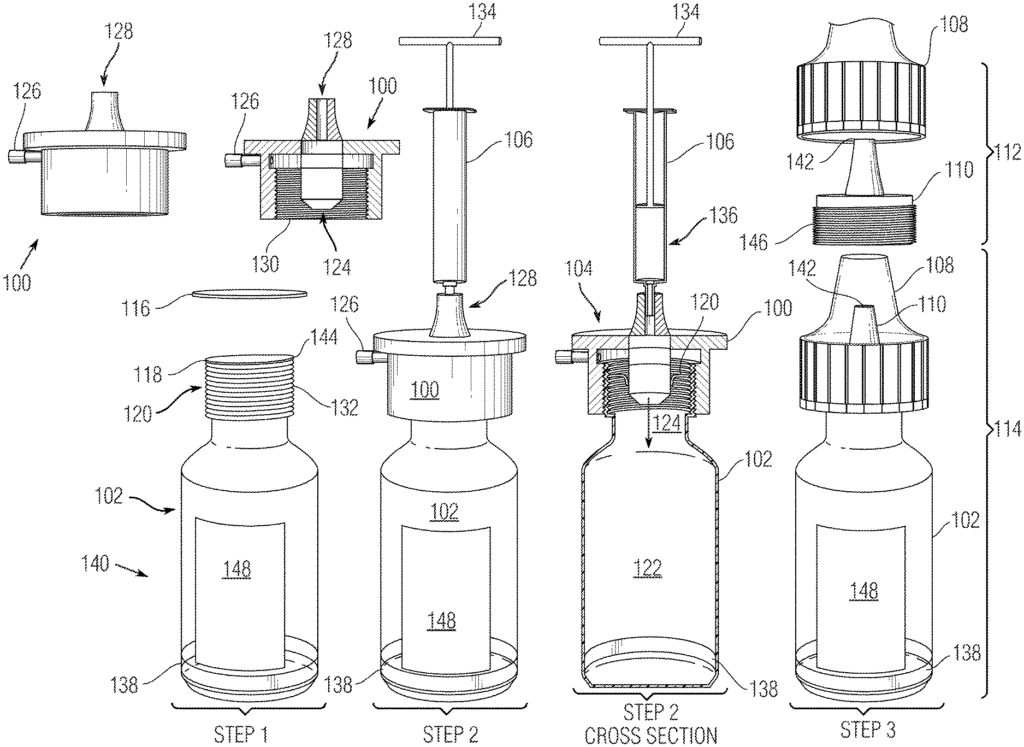
The ARCHON PHARMACEUTICAL CONSULTING LLC invention works as follows
A system and method of mixing compounds are disclosed. In one embodiment, a transfer device allows diluent to be introduced from a powder container into a container containing a first compound in a sterile way. In the second and third embodiments of the invention, systems for mixing and combining first and secondary compounds in first and two containers are shown. “Various dropper tips are disclosed for dispensing mixed compounds.
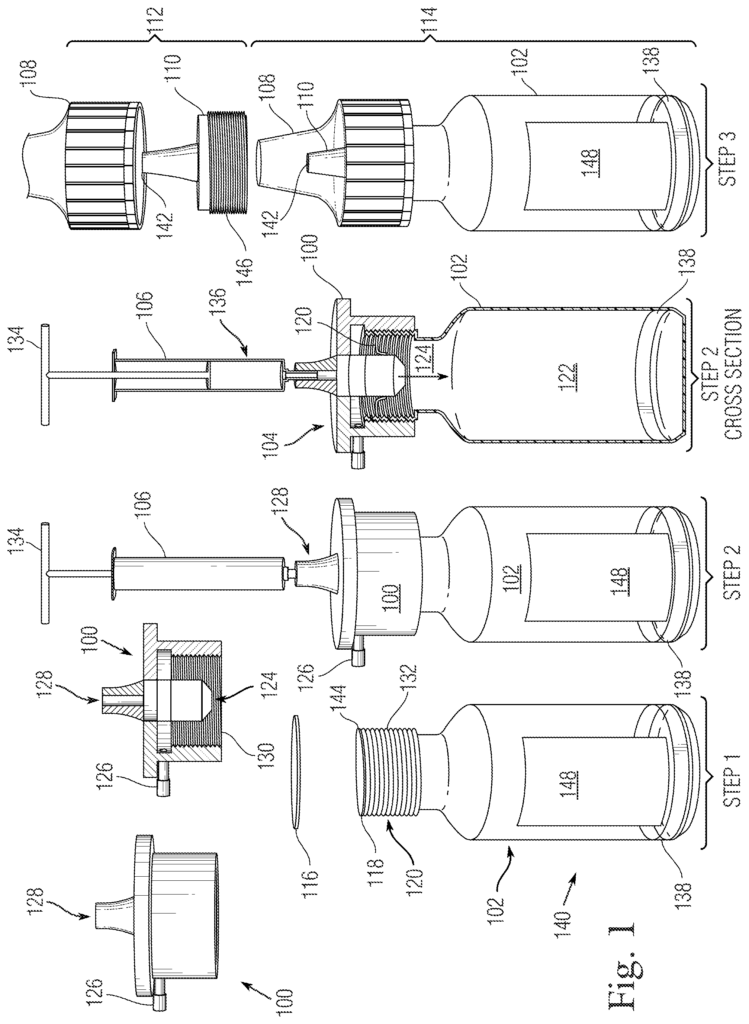
Background for System of compounding and packaging that is ready to reconstitute powdered ophthalmic drugs into a solution or a suspension to be administered to the eye of a patients
There is an unmet need for the development of a closed environment for pharmaceutical formulation that will allow healthcare professionals to easily compound and dispense therapeutically valuable and medically necessary medications, that are commercially unavailable due to relatively short drug stability, stringent compounding/manufacturing requirements and/or lack of proper facilities for sterile preparation of pharmaceutical products, from powder to a solution/suspension form.
A new and unique system is described for the compounding, labeling and dispensing of “Ready to reconstitute drug powders or solutions to solution or to a suspension or to an injection? The system can be used in a specific embodiment as an ophthalmic delivery container.
In one embodiment described herein, a Compounding System is disclosed that makes available to patients around the world (especially in areas where there are no sterile manufacturing or compounding facilities available) medications which were once unstable or not mixable with a short shelf life for multiple medical indications. The system can be used to prepare Ophthalmic Medication in one embodiment. In one embodiment, a system for multiple ophthalmic indications is used.
The system is designed to allow a patient or health care professional to reconstitute a powder or solution using a system which locks together.
The unique locking and vented device for transferring diluent onto a powder-containing drug bottle minimizes the risk that powders will be inhaled or contaminated by other mixing systems. The bottle can be a bottle used to dispense an ophthalmic medication.
The unique conical shape of the neck/transfer chamber allows the solution to transfer centrally, which reduces spillage and runoff when opened.
The sterile easy to screw on dropper tip and outer cap (which all interlock with the assistance of a locking/dimple/nipple) can be easily connected to the reconstitution bottle after opening the sterile packet that houses both items.
The bottom or clear side panel allows the patient to see how much solution is left after use.
In one embodiment, a dropper is fitted to the bottle. In one embodiment the drug is in Ophthalmic bottles. Ophthalmic bottles can be made in amber, clear, or opaque colors to address any potential drug/light sensitivities.
Compounders can use sterile gloves to protect both their compounded medications and themselves from exposure.
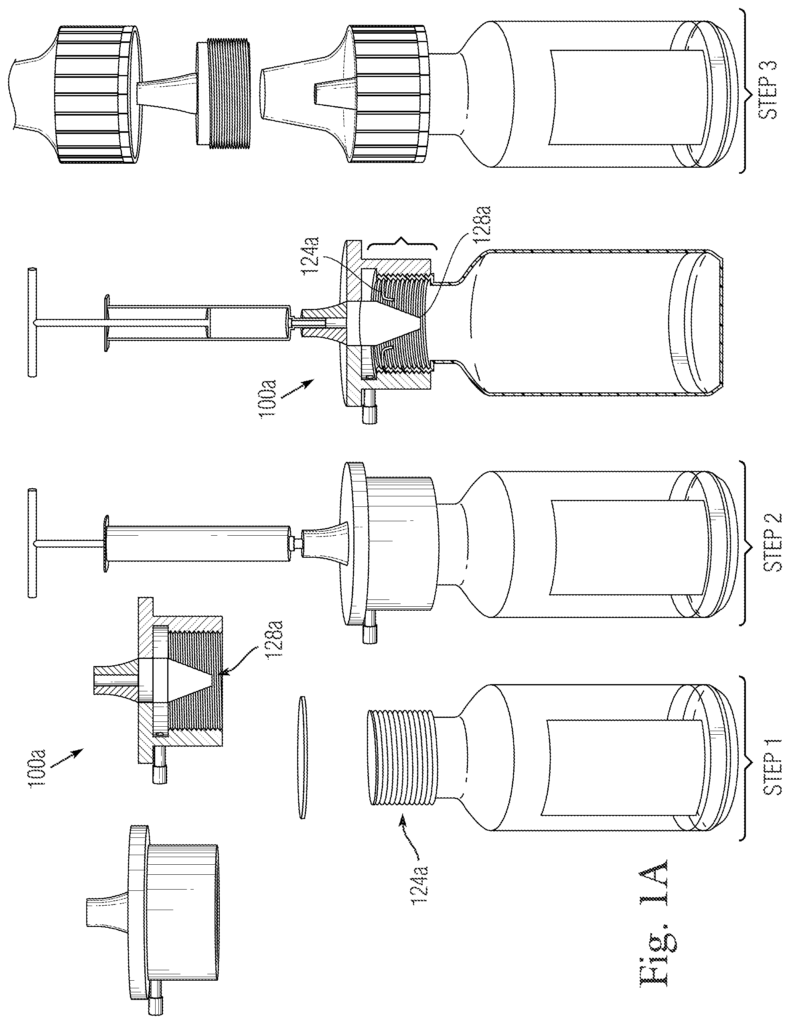
The pads of 70% Isopropyl alcohol are used to disinfect the connection point between the syringe, the transfer device, and the drug container. The bottle in a particular embodiment is an ophthalmic container.
The “Beyond Use Date/Discard After Date” stickers can be placed on the final product of the bottle that is ready for the patient to use. The bottle can be an ophthalmic container.
The present invention is a closed-environment pharmaceutical compounding system that allows healthcare professionals to compound and dispense therapeutically valuable and medically essential therapeutics which are commercially unavailable because of short stability dates or unique compounding needs, from powder to solution or suspension form. This closed environment will limit the exposure of the drug to microbial or particulate contaminants carried by the environment as well as protect the compounder/healthcare professional from potential topical or inhalation exposure of the medication (using some present compounding methods or devices). The pharmaceutical system can be used to prepare an ophthalmic medication in one embodiment.
Referring to FIG. The transfer device 100 includes a two-sided luer lock and threaded twist locking device with sterile vents and a luer lock. The transfer device 100 has a vent 126 and a luer lock 128 for locking and twisting engagement with a plastic bottle, such as the Ophthalmic Bottle. This plastic bottle contains a medication 140 in powder form that will be converted into a solution/suspension as described in greater detail below. The solution/suspension may be administered via a dropper or injection, intravenously or through other routes.
FIG. The FIG. Referring to FIG. Referring to FIG. In cross section, a diluent-syringe (106), connected to a transfer device 100 that is connected to an ophthalmic container 102 is shown.
Referring to FIG. “Referring to FIG.
Referring to FIG. 1 shows a cap 116 that is usually provided by the manufacturer. “If cap 116 is available, remove it from the ophthalmic container with powder 102.
The primary sterility barrier/aluminum sealing barrier 118 can be removed to reveal the opening of an ophthalmic powder bottle 102. The surface of the bottle and the rim on which the seal was located can be cleaned using a sterilizing agent.
The secondary sterility barrier is a conical drainage pipe 124 that is made of an inert sterile material. This will prevent the mixing chamber of the ophthalmic powder bottle 102 from opening until the membrane is broken.
As shown in FIG. “As shown in FIG.
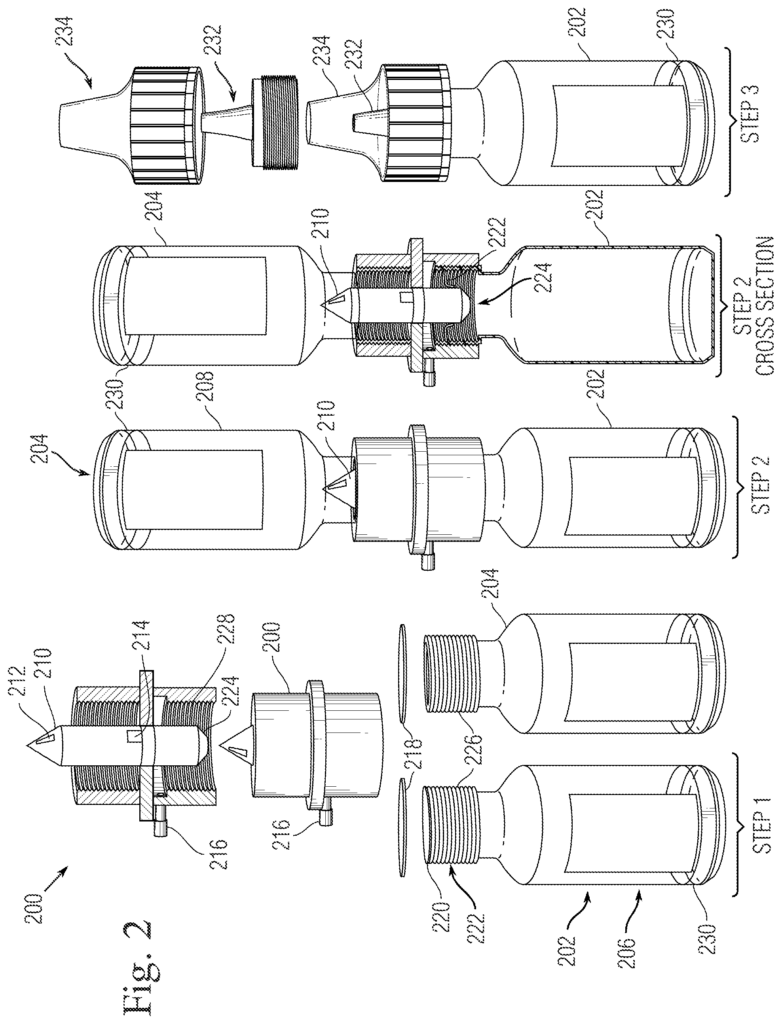
Click here to view the patent on Google Patents.
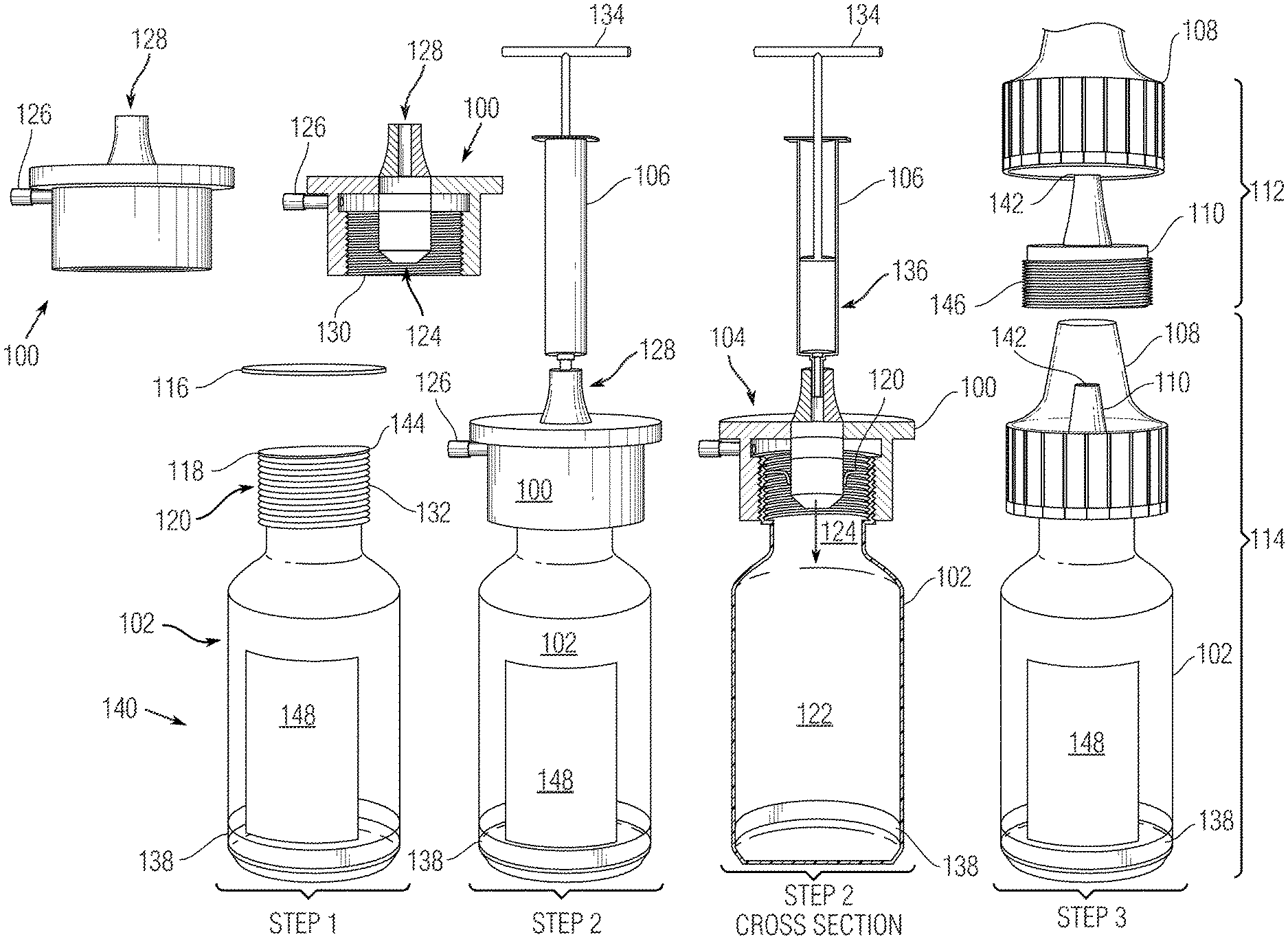
Leave a Reply